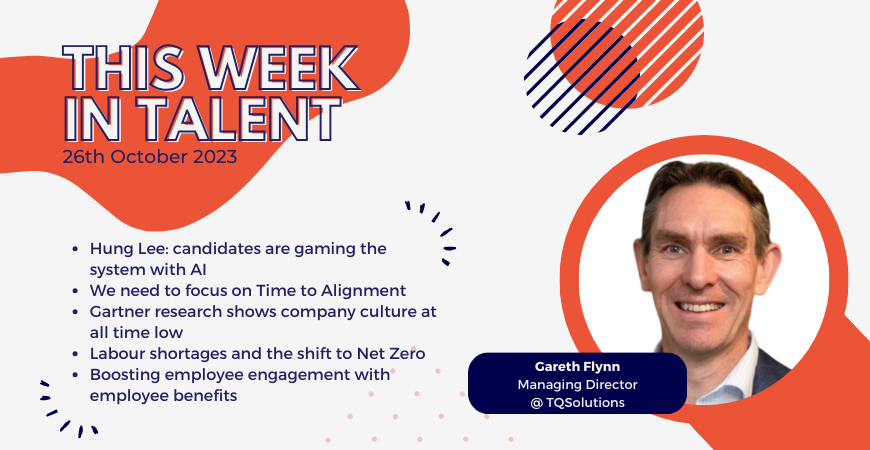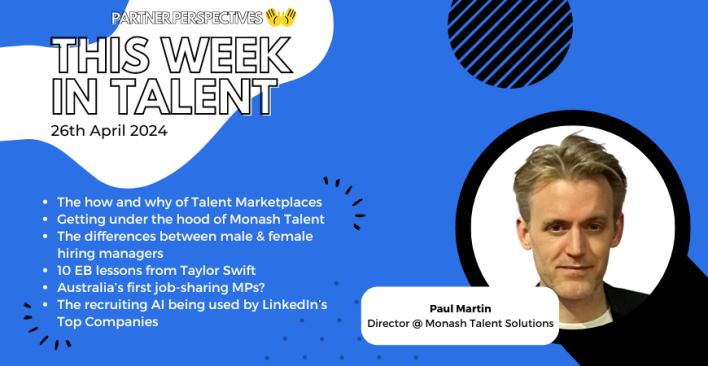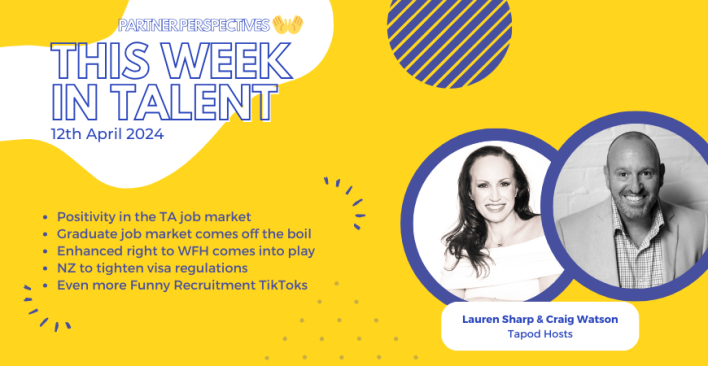This Week in Talent (26th October)

Blimey, October has disappeared in a flash, and this is my final TWIT editorial, thank you to Jo, Lucy and the ATC for inviting me to share my musings with you, it’s been good fun and I hope some of the material shared has been useful and of interest.
I have two things on my mind this week, one is the current state of the economy which is likely to be impacted further by geo-political events, and the second is the impact of AI on hiring practices and processes which I think will warrant a major re-design of how we source, screen and assess people.
First, on the economy, I am concerned that Australia is slipping into a steep decline as interest rates and cost of living pressures bite, dampening consumer spending, and major volatility globally is increasing risk as well as oil prices, putting further pressure on the RBA to raise interest rates to keep inflation in check. This could easily spiral downwards at a rapid rate. There has been a marked slowdown in hiring activities by corporate Australia in the past six months and I cannot see much of a reversal for the remainder of the fiscal year. It’s not a pretty picture.
Leaders of talent functions are going to have to quickly get their heads around future business demand and adjust their hiring forecasts accordingly. There is likely to be business/financial pressure to reduce FTE/costs in HR during this period and leaders should get on the front foot and prepare for this. Now is a good time to be looking at other activity and projects that are value adding that spare capacity can be directed to, but I would also be prepared for some further down-sizing of functions in heavily impacted sectors.
Second, I was listening to an interview with Hung Lee and the guys from TaPod yesterday which I have included in the content links. Whilst there has been significant talk about how AI will impact and transform hiring processes for TA teams and businesses, there hasn’t been as much talk about how AI will transform the activities and behaviours of candidates and job applicants. Hung gave a great insight into this during the interview, it’s really worth listening to.
Since Chat GPT arrived on the scene, there has been a significant number of apps and products launched using the technology in specific point applications. One of these applications serves jobseekers and is resulting in the automation of their job search and application activities. Once a person’s profile is uploaded and preferences captured the product will automatically find jobs that match and apply on your behalf, some products allows a candidate to apply to up to 2000 jobs per day!
I did a cursory search on google yesterday and these products came up on page 1:
www.Loopcv.pro ; www.sonara.ai ; www.aiapply.co ; www.tealhq.com/tools/autofill-job-applications ; www.bulkapply.ai ; www.autoapply.jobs
These are all widely available and there are scores more products and tools on the market doing similar things. These are potentially valuable to candidates and job seekers but what about the impact they will have on Talent Acquisition functions?
Some of the issues I foresee are:
- Application numbers are likely to increase significantly and as we know AI is not perfect when matching so the number of ‘poor match’ applications will rise. TA teams will have to somehow manage this to maintain ‘candidate experience’ objectives. Clearly, further automation will be required at the business end.
- Many firms still rely on cover letters, application forms and up-front assessments (volume hiring) to screen people in and out of hiring processes. In this new world, AI is increasingly completing this activity on behalf of the candidate and will work out how to ‘game’ the system to get through the hoops and hurdles. How will TA know how genuine or authentic an application is when AI is on the scene?
- Many hiring processes that have traditionally not managed ‘volume’ before will have to in the future especially as labour markets soften and the use of Auto AI Apply becomes more commonplace. All this additional activity will fall on TA professionals unless businesses re: think their practices and invest in their own technology.
Hung talked about three ways to address this – Deterrence (try to get people not to do this with policy); Detection (threaten omission if detected) and Design (re-design the hiring process to accommodate this new world). Listen to the podcast to delve into these options in more detail.
It is my view that ‘Design’ is the best option for TA teams. The genie is out of the bottle and is not going back in anytime soon, so now is the time to urgently review and re-design your hiring processes to accommodate the increased use of AI by businesses and by internal / external jobseekers.
We need to re-think our approach to sourcing (do we want to advertise every role when Auto AI apply exists?), screening (can this be business AI to job-seeker AI based rather than human to human) and assessment (is it time to go back to in person, pencil and paper?).
For companies being impacted by a reduction in hiring demand in the coming months maybe this is the time to use some of your capacity to re: think your entire approach to hiring in this new world. Do this now before hiring volumes rise again and you are trapped in a vicious cycle of increasing demand for your time from the business, coupled with a huge drain on your time managing AI driven application volumes.
So, that’s a wrap on my role as ‘Chief TWIT’- please feel free to connect with me on LinkedIn and if you are heading to the ATC at Luna Park in November, I look forward to seeing you there. Cheers!
Listen: Hung Lee on how candidates are gaming the system with AI
TaPod’s interview with Hung Lee from Recruiting Brainfood on the increased use of AI tools by candidates and the likely impact on TA teams.
Who owns the outcomes of Internal Mobility?
Link to TQ research poll on who owns the outcomes of Internal Mobility. The results are in and 33% of votes suggest that no one function owns it, it is shared across the organisations. 27% suggest its owned by business leaders, 22% the Talent Team and 18% the broader HR team.
The Most Important Recruiting Metric You’ve Never Heard Of: Time to Alignment
John Vlastelica introduces a new concept and metric of importance to TA, that is ‘time to alignment’. Misalignment wastes a lot of time and money in hiring practices today.
Company culture is at an all time low
Gartner research shows ratings of company cultures are at an all-time low in Australia and many firms risk losing skills / talent and not attracting the people they need.
Australia’s Path to Net Zero: The Critical Role of Labour and Skills
My colleague Nadine O’Regan attended the AFR Energy Summit and has shared her thoughts and insights from the event. Australia has a major challenge ahead of it if we want to meet our energy transition aspirations, and much of this is due to a lack of skills and workforce.
2023’s employment landscape, decoded
**SPONSORED**
With businesses bracing for a recession and more Aussie’s facing financial pressures, the role of employee benefits has never been more pivotal in boosting employee engagement and attracting top talent. Take a deep dive into insights from 3,000 Aussies, revealing the dynamic between stress, engagement, and employee benefits.
Related articles
Leave a Reply
Sign up to our newsletter
Get a weekly digest on the latest in Talent Acquisition.
Deliver this goodness to my inbox!


